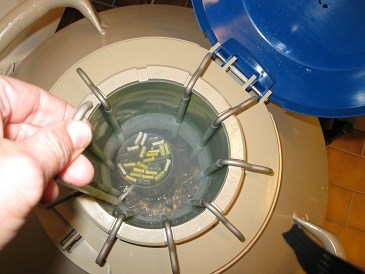Contact
Eva Axner
Professor at the Department of Clinical Sciences; Reproduktionsbioteknologi
Telephone: 018-672181
E-mail: eva.axner@slu.se

During the cryopreservation process, spermatozoa are exposed to hypertonic solutions contributed by the high concentration of cryoprotectant. During addition and removal of cryoprotectant the spermatozoa are subjected to a substantial osmotic stress. Spermatozoa of different species and different stages of maturation may have different susceptibility to osmotic stress depending on the biology of the cell membrane and this will affect their tolerance to the freezing-thawing stress.
The aims of this study were to determine the osmotic tolerance limits for motility, membrane integrity and mitochondrial membrane potential of feline epididymal spermatozoa and to study the effect of osmotic stress on the feline spermatozoa of different epididymal regions.
Epididymal spermatozoa from three regions (caput, corpus and cauda) were pre-exposed to various osmolalities (75, 300, 600, 900, 1200 mOsm) in a single step for 10 min and returned to 300 mOsm afterward. Percentage of motile spermatozoa was measured subjectively and membrane integrity (SYBR-14 positive cells) was evaluated prior to and after exposure to different osmolalities. The mitochondrial membrane potential (JC1) of spermatozoa were evaluated using flow cytometer and compared between epididymal regions (caput, corpus and cauda). All the parameters were compared using a mixed procedure.
The percentage of motile epididymal spermatozoa decreased significantly when spermatozoa were exposed to 75 mOsm and 600 mOsm. Epididymal spermatozoa showed signs of damage when pre-exposed to 900 and 1200 mOsm and returned to isotonic condition as significant reduction of membrane integrity and mitochondrial membrane potential were observed (P < 0.05). The plasma membrane of spermatozoa from the cauda epididymal region showed higher susceptibility to osmotic stress than the other regions as demonstrated by a significant difference between regions after return to isotonicity from 900 mOsm (P > 0.01) and a difference between caput and corpus after return from 1200 mOsm (P < 0.05). The corpus and cauda epididymal spermatozoa had higher percentage of spermatozoa with high mitochondrial membrane potential than those from caput when exposed to 75, 300 and 600 mOsm (P < 0.05).
In conclusion, a single step exposure to hypertonic solution of greater than 600 mOsm prior to return to isotonic condition can cause severe damage to sperm membrane and mitochondrial membrane potential compared to non-returning (exposure to various osmolality but not returned to isotonic condition). Changes in osmolality impacted mostly on sperm motility. Spermatozoa from cauda epididymis were more susceptible to osmotic stress compared to those from corpus and caput indicating that the maturation changes in the sperm membrane during passage through the epididymis increase susceptibility to the osmotic changes that may occur during sperm cryopreservation.
https://doi.org/10.1016/j.anireprosci.2017.08.014
Panisara Kunkitti, Kaywalee Chatdarong, Junpen Suwimonteerabutr, Teerawut Nedumpun, Anders Johannisson, Ann-Sofi Bergqvist, Ylva Sjunnesson, Eva Axnér. Osmotic tolerance of feline epididymal spermatozoa. Animal Reproduction Science (2017), volume 185, pages 148-153
Eva Axner
Professor at the Department of Clinical Sciences; Reproduktionsbioteknologi
Telephone: 018-672181
E-mail: eva.axner@slu.se